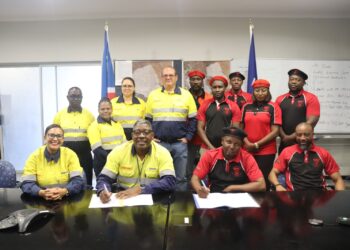
Namibia is targeting to convert more than 120,000 fuel combustion engine vehicles to use green hydrogen by 2030, as premised in the National Determined Contribution climate change strategy.
Speaking in Dubai, at the World Green Economy Summit, ahead of COP28 set to begin on Thursday, the Minister of Environment, Forestry and Tourism, Pohamba Shifeta, said the convention will be extended to boats and ships as well.
“The green hydrogen project is expected to produce about five terra watts of electricity. This would exceed domestic demand and make Namibia’s electricity 100% renewable by 2030,†Shifeta said.
“The green hydrogen also has the potential to significantly reduce the emission from the transport sector. Therefore, I can confidently say Namibia is definitely on the right track to achieve its long-term low emission development goal.
“The challenges we foresee with the green hydrogen initiative include the storage and transportation facilities. The distance from the potential markets also presents a competitive challenge. However, with the development of new technologies, we hope that these challenges can be addressed so that Namibia can develop a vibrant green hydrogen economy,” he added.
Shifeta made the remarks while addressing some of the progress, challenges and solutions Namibia has in place in accelerating the development of the green hydrogen sector, including how it can be of benefit and use.
In addition, he said the implementation of Namibia’s NDC is conditional, as it is expected that 90% of the total estimated cost of US$15 billion (N$282.9 billion on today’s exchange rate) will come from the multilateral and bilateral funding windows.
With increased funding, Shifeta says, it will help to have access to predictable and adequate financial resources vital in implementing the NDCs.
In addition, the Minister highlighted the role renewable energy plays in accelerating the goals of Vision 2030, which aims to transform Namibia into an industrialised country of equal opportunities, which is globally competitive, realising its maximum growth potential on a sustainable basis, with improved quality of life for all.
Other targets relate to developing Namibia’s natural capital and its sustainable utilisation, for the benefit of the country’s social, economic, and ecological well-being, as well as to accomplish the transformation of Namibia into a knowledge-based, highly competitive, industrialised, and eco-friendly nation, with sustainable economic growth and high quality of life.
“Namibia has put in place a number of initiatives to promote renewable energy for the past 10 years. We now have about 120 megawatts of installed capacity from solar energy sources. This has been achieved through private sector investment and facilitated through a comprehensive policy on power purchase agreements between the state-owned enterprise, the Namibia Power Company (NamPower) and independent power producers (IPPs),” he said.
“Additionally, there is a Cabinet directive to have all the public schools and hospitals as well as other government buildings electrified with solar energy including solar water heating systems. Most importantly, Our NDC commits to promote the production of electricity through renewable energy sources including Green Hydrogen. Electricity from renewable sources (such as solar and wind) met nearly 96% of local production in the base year 2016,” the Minister added.-miningandenergy.com.na











